Day 3 of a three day long weekend of Summer Tours today, our last day. We were heading down to the Brecks today. The weather has been getting progressively hotter, and today was the warmest of the days we were out. It was bright and sunny in the morning and, although it did cloud over a little in the afternoon, it was still hot and humid.
The Peregrine was back on the church tower again this morning, so once we had picked everyone up we took a short detour round to see it. It had just finished devouring its breakfast and was digesting, perched high on one of the stones protruding from the tower, dozing in the morning sunshine. We got the scope on it and had a fantastic, full-frame view.
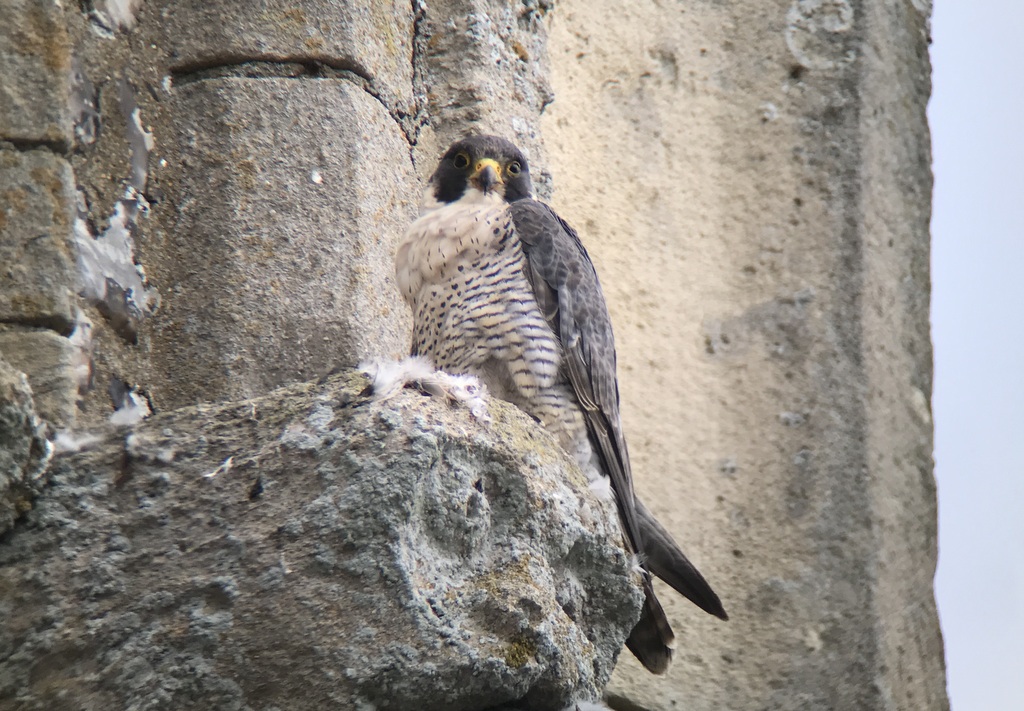
It was such a treat to get so close views of a Peregrine, we eventually had to tear ourselves away to head off on the journey down to the Brecks.
Once we got into the north Brecks, we took a detour off the road to look for Stone Curlews. At the end of the breeding season they start to gather in larger flocks in favoured fields, and we hoped to find some today. We stopped to scan the field where they have been recently, but we couldn’t find any there this morning. Then we heard Stone Curlews calling and realised they were in the field the other side of the road.
There is a thick hedge the other side of the road and it is impossible to see into the field, so we walked up to try to find a gap from where we could view. Some of the Stone Curlews must have been close to the hedge, because they took off and flew round, over our heads and across the road to the field we had been scanning. Two swung round and dropped down in view, but the rest, at least another ten, flew out to the middle of the field. The ground slopes away here and they dropped in out of view.
Turning our attention to the two Stone Curlews which had dropped down where we could see them, we trained the scope on them and had a great look at them. We could see their staring yellow iris and short black-tipped yellow bill, very unlike a curlew. They are not members of the curlew family at all, just named for their curlew-like calls, but actually members of the thick-knee family.

One of the Stone Curlews sat down in the stony field and promptly all but disappeared – they are very well camouflaged! While we were watching them, we heard Tree Sparrows calling and looked across to see two land in a large bush out in the middle of the field. Through the scope, we could see the black spots in the middle of their white cheeks.
Our main destination for the day was to be Lakenheath Fen. Unfortunately, we had to take a big diversion to get there today. We hit a big traffic jam at Weeting, where the traffic had backed up trying to get into this weekend’s Weeting Steam Rally. The tailback was right through the village and almost back to the main road! The organisers really need to do something about their chaotic parking arrangements next year – they clearly could not cope with the number of cars arriving. The diversion did at least yield a Mistle Thrush on some wires by the road as we passed.
We eventually arrived at Lakenheath to find they had their own ‘bioblitz’ event on today. While we were arranging access permits, we had a quick look at the various creatures they had already gathered. Unfortunately they had not kept many of the most interesting moths from the moth traps, but we did have a look at the Poplar Hawkmoth and Garden Tiger moths which had been put onto one of the screens round the back of the visitor centre.
One of the group had wandered back towards the car park, and saw the first Bittern of the day. It was a distinctive female with an injured leg which hangs down in flight, known as ‘Gammyleg’. It had disappeared off upstream along the river towards Brandon Fen, away from the reserve.
We needed to limit the amount of walking for the group today, so we were granted a disabled permit and drove out to the disabled parking area by New Fen viewpoint. We walked up to the viewpoint and looked out over the reedbed. Apart from a few Coot, a Moorhen and a couple of Mallard, there was not much to see here today. It was already hot, and activity levels seemed to have dropped.
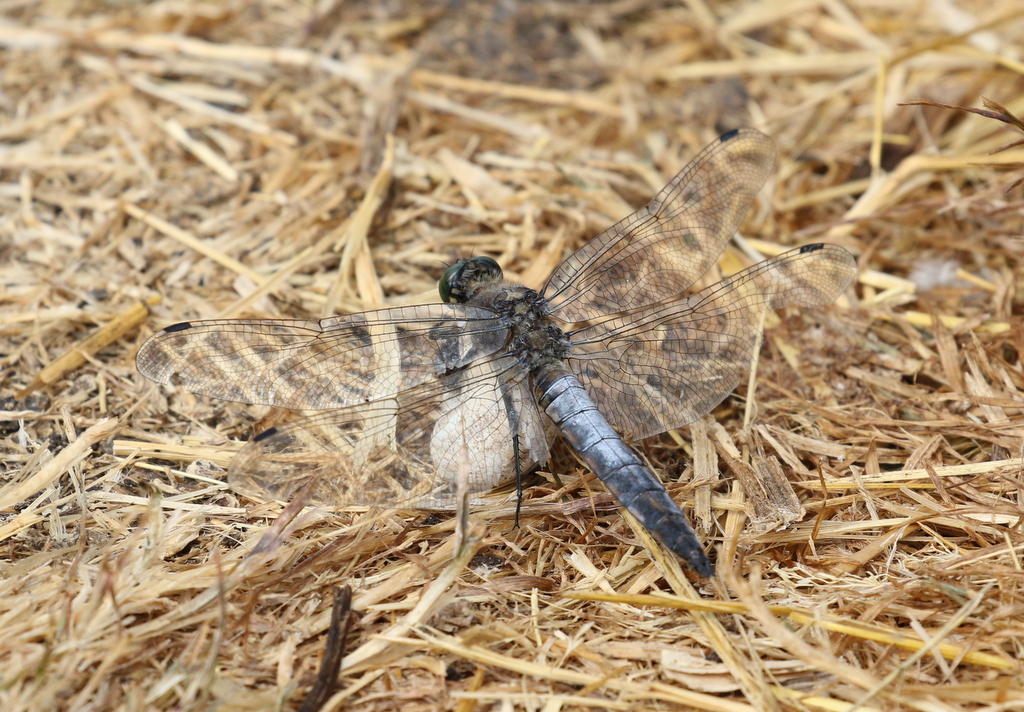
The number of dragonflies and damselflies here is starting to tail off now, but walking out along the bank on the south side of New Fen we still saw a good variety. There were lots of Brown Hawkers hawking over the reeds and an Emperor Dragonfly patrolled up and down the path, past us. One or two Black-tailed Skimmers were basking on the path and flew off ahead of us. A couple of rather worn Four-spotted Chasers perched on the reeds, but the Ruddy Darters were looking much smarter. Damselflies included Common Blue, Blue-tailed and Red-eyed Damselfly.
There were a few butterflies too – Red Admiral, Peacock, Comma and Large White. A Brimstone was feeding on some burdock flowers.

One or two Common Whitethroats darted out of the vegetation ahead of us and we saw a couple of Reed Warblers which disappeared into the reeds as we approached. The warden and one of his assistants were out in a boat, collecting things for the ‘bioblitz’, and flushed some Grey Herons from the reeds. When they had all taken to the air, sixteen birds were flying round together in a big flock! Three Little Egrets flew past, upstream along the river and a Green Sandpiper disappeared off that way too.
We hadn’t gone too far before we spotted the first Bittern for the rest of the group. It was rather distant, over the far side of New Fen. It flew across over the reeds and dropped down out of sight. A little further on, we turned to see another Bittern coming round the far corner of the wood back behind us, away in the distance. We watched as it headed steadily towards us.
When it got closer, we could see that it had a dangling leg – it was ‘Gammyleg’, the female Bittern one of the group had seen earlier. It flew in right past us and dropped down into the reeds a short distance ahead of us, giving us great flight views as it did so. It is feeding young at the moment, so had obviously been off along the river collecting food.
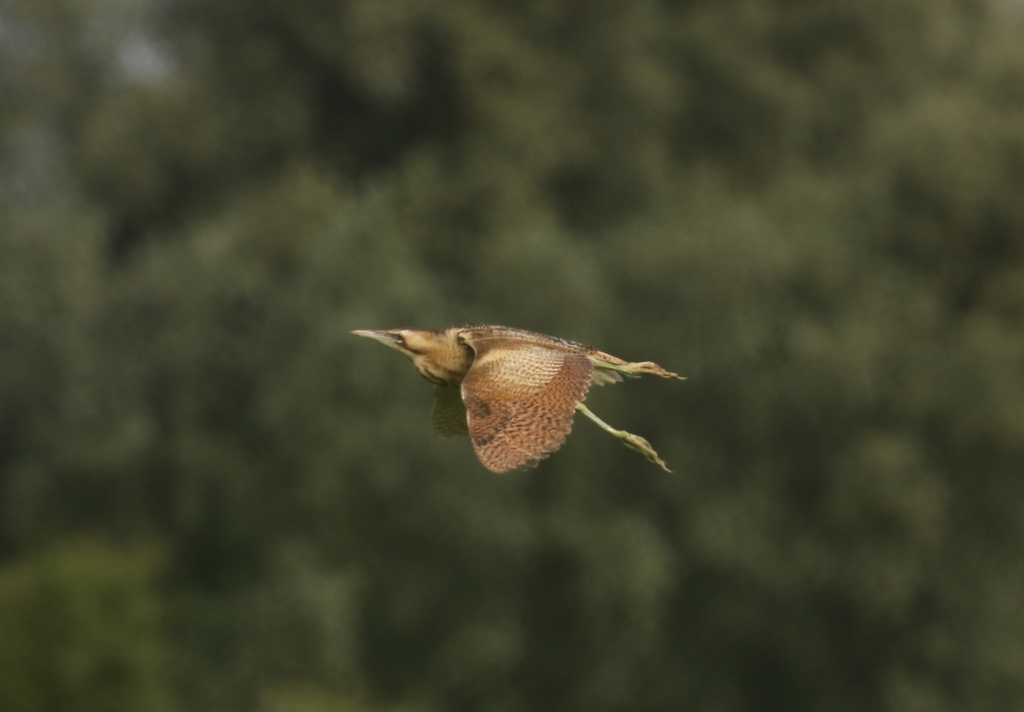
We walked up to where the Bittern had seemed to go down and scanned the reeds, as much as we could see into them, but there was no sign of it. We hadn’t gone much further along here before we looked back to see ‘Gammyleg’ heading off again, back round the far corner of the wood, presumably back to where it had been feeding earlier.
There had been a family of Bitterns seen from Mere Hide in recent weeks, but they have not been seen for a few days. That much was immediately apparent also from the fact that we had no trouble getting into the hide. When the Bitterns were showing, it was impossible to get in, as the place was packed out with photographers taking up occupation of the place from dawn to dusk! We had a quick sit down and scan, before moving on.
The family of Great Crested Grebes is still on one of the pools by the path out to Joist Fen. The four juveniles are now pretty much fully grown – too big to ride on mum or dad’s back now. They still have stripy faces, which distinguishes them from the adults.
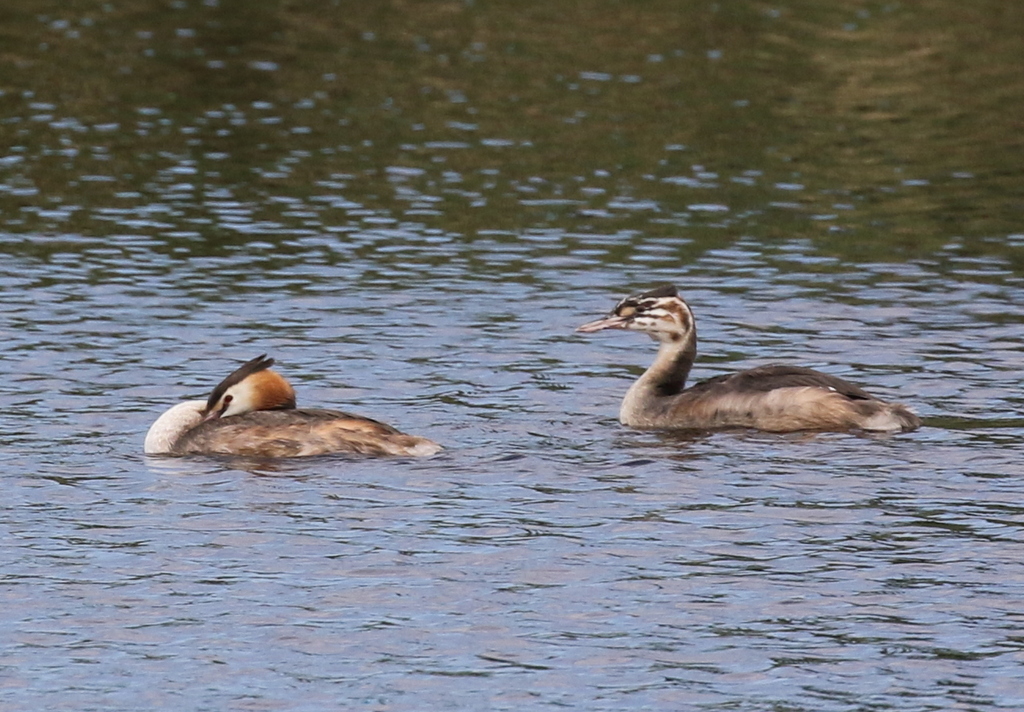
A little further on and a Red Kite appeared from beyond West Wood, flying in low over the river before circling up over the trees. As we got out to Joist Fen, we started to see more Marsh Harriers and there were several juveniles out from the viewpoint, indulging in a bit of flying practice over the reeds.
The Hobbys can be harder to find here at this time of year, but we did manage to locate one from the viewpoint. It was very distant though, circling up right at the back of Joist Fen. There wasn’t much else happening out here today though, so after a short rest we set off back. On the way, a Common Buzzard was circling over the corner of West Wood now.
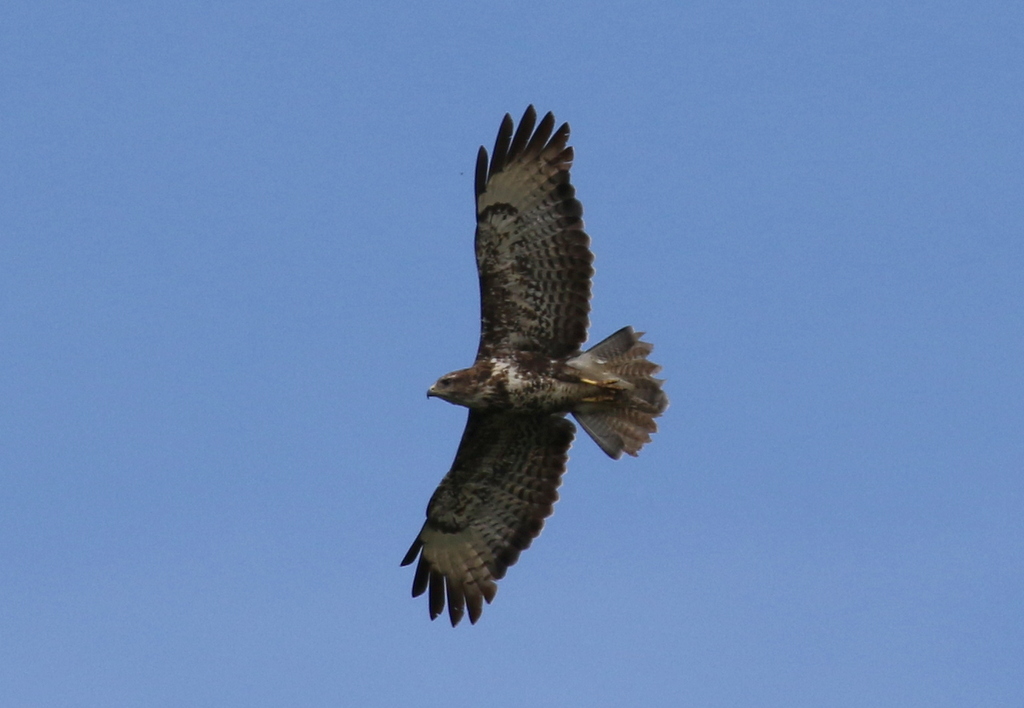
We could hear a Kingfisher calling from the poplars, but we couldn’t see it. It was getting quiet hot now, so we made our way back to the car and headed back to the visitor centre for lunch.
After lunch, we walked up to the Washland viewpoint. The water on here is evaporating fast now, which at least has the advantage of making it attractive to waders. There were quite a few Black-tailed Godwits feeding in the shallow water and a large flock of Lapwing on the mud at the edge. In with the latter, were three Curlew and an Oystercatcher too. A single Common Redshank was wading out in the middle. A few Common Terns were hawking around over the remaining water.
The temperature and timing, in the middle of the afternoon, was not really conducive for looking for passerines, but we headed off to Lynford Arboretum to try our luck. We could hear Siskin calling as we got out of the car and saw one flying off from the top of the larches as we walked down through the arboretum. A Nuthatch was calling from somewhere in the distance, but otherwise it was very quiet in the trees.
We walked down to the bridge and someone had put some seed out on one of the pillars. Several Chaffinches were busy feeding here, but nothing else. A Goldfinch came down to drink in the paddock just beyond. We decided to have a look round the lake.
The Little Grebes here have obviously had a successful breeding season – first we found a very advanced juvenile on its own, then an adult feeding a very well-grown juvenile under the over-hanging trees (we could hear its begging calls first), and finally we came across another pair with three very small juveniles.
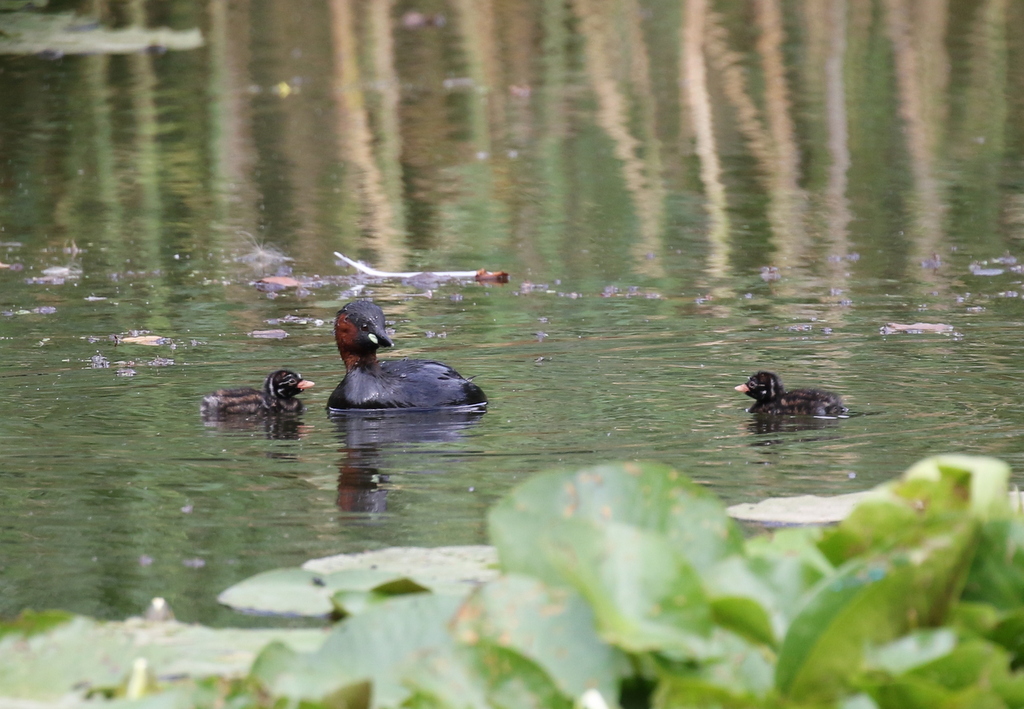
There was not much sign of any passerine activity down around the lake either, so we headed on round to the weir to see if we could find one of the Grey Wagtails. The water has largely stopped flowing out of the lake now, beyond a trickle, but as we walked in through the trees a Grey Wagtail flew off from the near bank and landed on an upturned wooden box out in the middle. We watched it bobbing its tail, before it flew back and started to feed along the far edge.
Looking back to the weir, we noticed some ripples in the water at the bottom and looked across to see a small mammal. It appeared to be bathing at first but when we looked more closely, we realised it was feeding, diving under the water. It was a Water Shrew – something we see very rarely. It surfaced with something in its mouth and hopped out onto the rocks, disappearing off to the bank. A few seconds later, it reappeared and ran down into the water again.
We stood and watched the Water Shrew feeding for several minutes – it was fascinating to observe one for an extended period, as normally all you see of them is one disappearing off in the water. We could see its long pointed nose, black fur contrasting with paler silver belly and quite a long tail. Eventually the Water Shrew disappeared into the rocks again and we decided to walk back.
When we got back to the bridge, activity seemed to have picked up a bit. The Chaffinches were still feeding on the seed on the pillar, but as we walked up we heard a Marsh Tit calling immediately behind them. It was flicking around in the trees just beyond, low down, hanging on the branches and picking at the underside of the leaves. A Treecreeper called and appeared from around the back on the trunk of the tree right beside us.
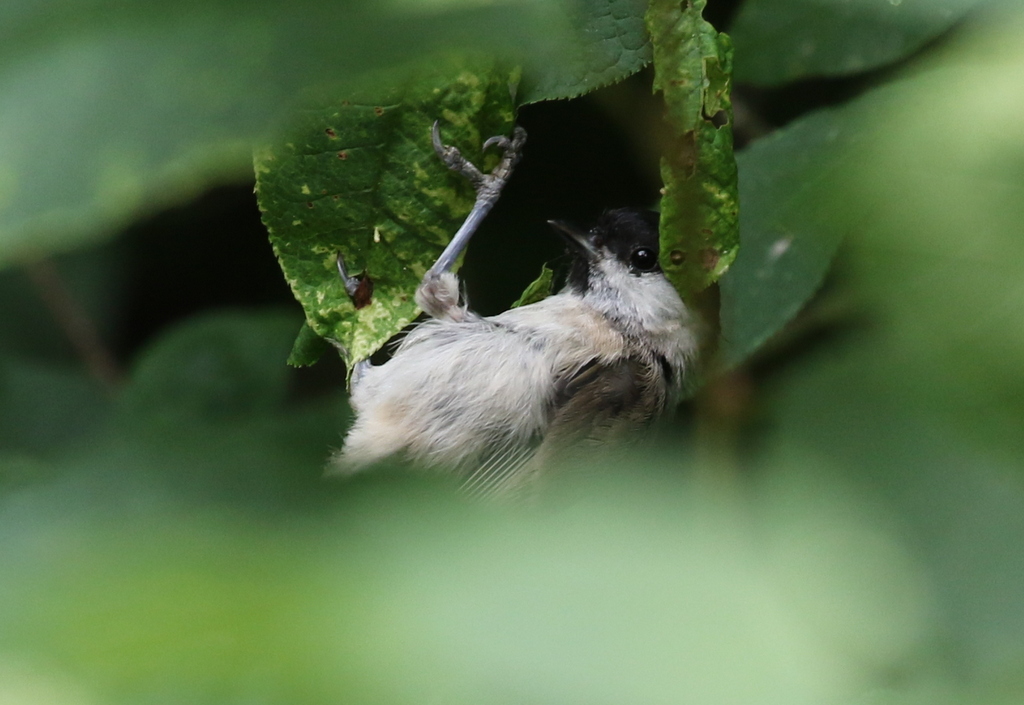
Walking back up through the middle of the arboretum, we came across a large tit flock. A Nuthatch was with them, in a tall birch tree. Unusually, it was feeding by hovering and trying to pick insects off the leaves – not something you see often. There were also Long-tailed Tits, Coal Tits, Great Tits and Blue Tits.
The afternoon was getting on now and it was time to be heading back. On the way, we called in briefly at a clearing in the forest. There have been Tree Pipits breeding here, but there was no sign of them this afternoon. A male Yellowhammer appeared briefly in the top of a young oak tree, with food in its bill. Presumably it still has young in the nest nearby.
We had a quick walk to the edge of the clearing. Several birds flew out of the dense bracken and dropped back in further along. A mixed tit flock were feeding in here, possibly finding more food here in the cool, dark conditions, and with them were a couple of Blackcap and one or two Common Whitethroat.
Unfortunately, we were out of time and we had to head for home now. It had been an exciting three days with a great variety of birds and other wildlife, some of the best Norfolk has to offer in summer.
















